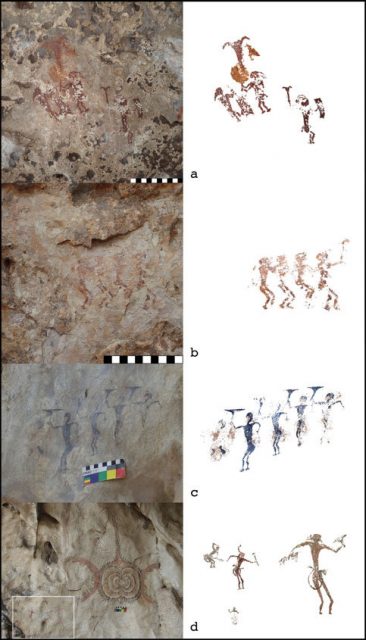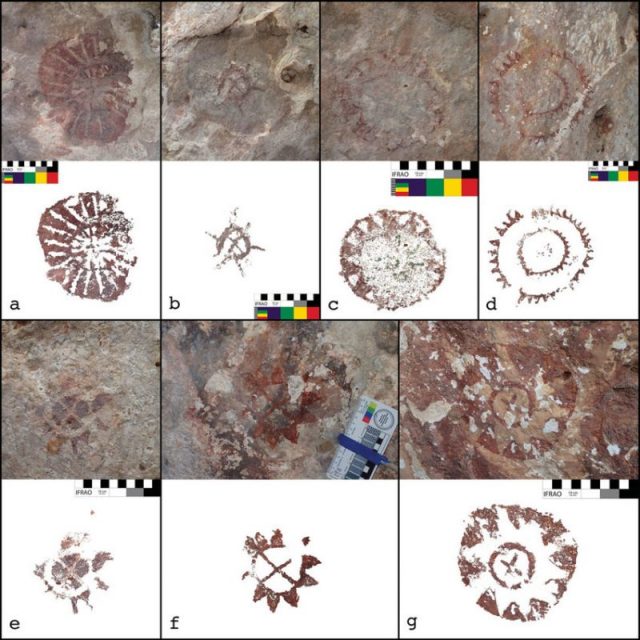Cave paintings are endless fascinating.
Indonesia is a country comprised of thousands of islands, and one of them, a small island named Kisar (measuring not more than 31 square miles and home to approximately 28,000 people) has gained prominence as scientists have come across 28 cave paintings, as old as 2,500 years that depict both figures of humans and animals, among other objects.
A portion of the cave imagery reveals people holding what may resemble shields, while in other instances people can be noticed sporting drums and possibly participating in some kind of ceremonies. Although the size of the images is very small, they are significant for a number of different reasons.
First, they are similar to drawings found on Kisar’s neighboring island just on the south, Timor-Leste. Secondly, some of the cave images are reminiscent of other images that can be spotted on metal drums originating from territories such as the north of Vietnam as well as southern China, the production of which has started some 2,500 years ago. That probably points to trade routes which functioned in the region around that time.
Professor Sue O’Connor from the Australian National University, one of the lead researchers on the Kisar cave artworks, stated that: “Archaeologically, no one has ever explored this small island before.” She has also remarked on the connectedness of Kisar with Timor-Leste, saying, “These Indonesian islands were the heart of the spice trade going back for thousands of years. The paintings we found depict boats, dogs, horses and people often holding what look like shields.”

In essence, indeed, the paintings have offered an insight into a history of trade and culture in this corner of Southeast Asia. Researchers have emphasized the significance of the relationship of the Kisar cave artwork with the images found on the neighboring Timor-Leste.
As O’Connor commented on this matter: “The Kisar paintings include images which are remarkably similar to those in the east end of Timor-Leste. These paintings perhaps herald the introduction of a new symbolic system established about two thousand years ago, following the exchange of prestige goods and the beginning of hierarchical societies.”
A commonly shared trait of the artwork noticed on both the islands is the “exceptionally small size of the human and animal figures.” The images are not bigger than four inches, but yet, their dynamic has been noted to be a striking one, potent with culturally significant information for the region.
Related Video:
According to archaeologists, the relationship between the people of Kisar and Timor-Leste goes back as far as 3,500 years ago, that was still the Neolithic days, though some of the images may be of much more recent date, according to more commentaries made.
The dynamic of the images certainly ties with the newly introduced goods in the area, domestic animals such as dogs for example, and maybe also certain crops. These goods may have well been brought by incoming Austronesian settlers, who possibly sailed all the way from far island territories such as the Philippines, Malaysia, Fiji, or Polynesia, and they all played role in forging the relationship between both Kisar and Timor-Leste.

More about the research can be followed through in a study that was issued in the Cambridge Journal of Archaeology. Aside from Australian researchers, it was also Indonesian researchers who took part in the framework of activities, and this is not the sole case in which scientists from both these countries have come together in joint research efforts. Neither are the Kisar’s cave paintings the oldest ones ever found across the islands of Indonesia.
Only a few years back, Australian and Indonesian scientists helped establish that some paintings of hands and animals, located in as many as seven ancient limestone caves on the Indonesian island of Sulawesi, may be as old as some of the oldest known European cave artwork. Some of the Sulawesi cave artworks have been set to be around 39,000 years of age.
